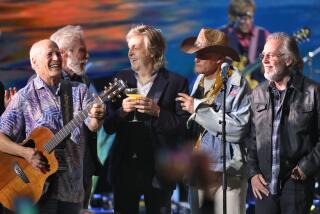Botti Proves Ready for the Big Time
- Share via
Trumpeter Chris Botti’s performance at the El Rey Theatre on Monday night--videotaped for a television special--was an impressive step forward for a performer who seems to possess all the qualities of a breakout musical star. Visually charismatic, musically engaging and appealingly personable, he generated a consistently enthusiastic response from a crowd filled with music industry professionals.
The buzz about Botti has been present for several years, with many of his advocates wondering why his impressive musicality and movie-star good looks haven’t produced a Diana Krall-like breakthrough. Part of the problem has been Botti’s own decision to devote a substantial amount of time to touring in Sting’s backup ensemble rather than do the tough legwork to drive his own career.
But for this night, at least, it was Botti who was in the spotlight, with Sting initially present in the audience, later coming on stage to sing “In the Wee Small Hours of the Morning” and his own “Bourbon Street.” The set was further enhanced by the appearance of Shawn Colvin, singing Sting’s “All Would Envy” and her own “The Facts About Jimmy.”
Botti’s ability to not simply hold his own, but to stand out in such relatively fast pop-world company, was convincing testimony to his potential. And what makes that potential even more intriguing is the quality of his playing. One of the curious anomalies about smooth jazz is the fact that trumpeters who work within the genre seem so closely connected to straight-ahead jazz. Players such as Botti and Rick Braun display obvious linkages to Miles Davis and Chet Baker. Saxophonists such as Dave Koz and Richard Elliot, among many others, more often look to sources such as David Sanborn, David “Fathead” Newman and (oddly enough) honkers such as Big Jay McNeely, rather than Charlie Parker or John Coltrane for inspiration.
Botti’s playing, even without resorting to a Harmon mute, was obviously, and deeply, impacted by Davis. But there was never a sense of simulation or imitation--rather, a feeling of natural flow, of a young artist seeking, and using, the most communicative aspects of a primal jazz style.
Botti still needs to be more discriminating in his choice of material; his composing skills do not yet match his playing abilities. He needs to make a consistent commitment to his own artistic future. And his management team needs to assemble the sort of cohesively organized career game plan that worked so successfully for Krall in her earlier career.
If and when those elements are in place, Botti has the capacity for a Kenny G sort of visibility. Better yet, if he sticks with his present musical orientation, it will be a visibility in which improvisation and imagination play vital roles.
More to Read
The biggest entertainment stories
Get our big stories about Hollywood, film, television, music, arts, culture and more right in your inbox as soon as they publish.
You may occasionally receive promotional content from the Los Angeles Times.










